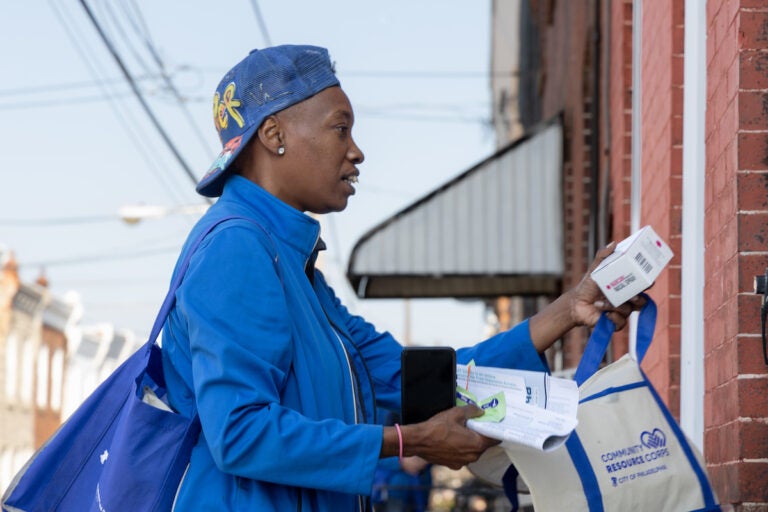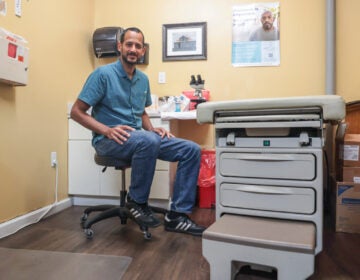Philly adopts new door-to-door canvass approach to prevent drug overdose deaths
The new Philly Counts project aims to reach 100,000 doors in city “hot spots” of drug overdose deaths in Black and brown communities.
Listen 4:29
Marsella Elie, a canvasser for Philly Counts, gives opioid overdose reverse drug Narcan to a North Philadelphia resident as part of an initiative with the city’s Office of Community Empowerment and Opportunity to get harm reduction resources into homes in areas heavily hit by the opioid crisis. (Kimberly Paynter/WHYY)
From Philly and the Pa. suburbs to South Jersey and Delaware, what would you like WHYY News to cover? Let us know!
A small group of people dressed in royal blue shirts gathered in the far corner of a parking lot on North 5th Street in North Philadelphia.
It’s the meet-up spot of the day for outreach workers and canvassers with the city Office of Community Empowerment and Opportunity’s Philly Counts team.
On a recent Thursday morning, about 20 canvassers were in Franklinville to distribute the opioid overdose reversal medication Narcan, fentanyl test strips, and resource guides on substance use and addiction treatment services.
Their goal is to spread awareness about rising drug overdose deaths in the community, particularly among Black and brown residents, and equip people with tools to help those struggling with substance use issues.
“For years we’ve known that overdoses are rising in Black and brown communities in the city of Philadelphia,” said Keli McLoyd, deputy director of the city’s Opioid Response Unit. “In those communities, for very valid reasons, people may not be willing to raise their hands and identify as a person who uses drugs. That is fine and well, but we also believe that those people should still get to live.”

A record 1,413 people died in Philly last year from drug overdoses, according to city data. Fatal overdoses were up 20% among Black residents from the year before, with many happening in private residences and behind closed doors, city officials said.
Historically, McLoyd said Black and brown people who use drugs have suffered disproportionate rates of arrests, incarceration, and child welfare charges. She said because of those punitive outcomes, people may hesitate to actively seek out harm reduction or treatment services.
The new door-to-door canvassing approach aims to cut through some of that hesitancy, stigma, and shame that can come from someone openly sharing their struggles with substance use.

McLoyd said it also seeks to normalize Narcan as an everyday medicine cabinet or household item.
“So many times, we look at Narcan and we say, ‘Oh, well, I don’t need that. That’s for those people over there. That’s for those people that are doing those things,’” she said. “But it’s just like any other medication. I hope that most people will never have to use this, but I also hope that if they ever have to use it, they know it’s there.”
The project focuses on Philadelphia “hot spots” with increases in overdose deaths outside of the Kensington and Allegheny neighborhoods, where street drug use is most visible and harm reduction services and resources are typically concentrated.

In the Franklinville area, about 85 people died last year from fatal overdoses, city data shows.
Outreach worker Marsella Elie said the numbers surprise some people, including a resident she recently spoke with while out canvassing.
“He was like, ‘You should be in Kensington and Allegheny’ and I was letting him know, like no, this is here. This is why we are here,” she said. “It’s not just Kensington and Allegheny. It’s really out here and people need to be aware that.”
The city’s project with Philly Counts aims to hit more than 100,000 doors in certain zip codes across the city, starting with neighborhoods in North Philly.

In the first week earlier this month, canvassers knocked on about 2,400 doors and spoke to 411 residents — a 17% contact rate. Workers will sweep through neighborhoods a second time in order to reach people they may have missed in their first pass through.
The initiative is partially funded with the city’s share of national opioid settlement payouts from pharmaceutical distributors and manufacturers.

Elie said this project is different from others she’s canvassed for in the past. She said she wished some of these resources were available for friends who have died from drug overdoses.
“I’m doing this because I like helping people,” Elie said. “Knowing that I got [Narcan] in a household, that makes me smile.”
For the most part, outreach worker Mitchell Bormack said people are receptive to what he has to say and the materials he is distributing.
“We’ve gotten a lot of people who say their son or daughter has a problem. I had someone whose father overdosed from heroin like seven years ago,” he said. “One woman I spoke to yesterday said, ‘Oh man, I wish you’d been here like a week ago because I would have given this stuff to my neighbor across the street who just [overdosed] and died.’”
While canvassing Thursday, Bormack came across resident Katherine Camacho, who said she’d gladly take the resource guides and fentanyl strips. She said she’ll keep the Narcan on her in case she ever has to use it on someone who’s overdosing.
Camacho also agreed to get additional training from the city to become a trusted messenger, someone who can continue to spread awareness and distribute information in her community.

“You never know too much,” she said. “God’s putting these people to help at these times, the worst times, that we’re seeing. It’s so sad that kids have to see this growing up, and us adults, we have family members that see this. It’s a battle.”
There’s no official end date to the canvassing project. City officials said the project will continue for as long as it takes to reach as many doors and people as they can.
If you or someone you know is struggling with substance use, SAMHSA’s National Helpline is a free, confidential, 24-hour hotline that offers referrals to local treatment facilities, support groups, and community-based organizations. Call 1-800-662-HELP for more information.
WHYY is your source for fact-based, in-depth journalism and information. As a nonprofit organization, we rely on financial support from readers like you. Please give today.





